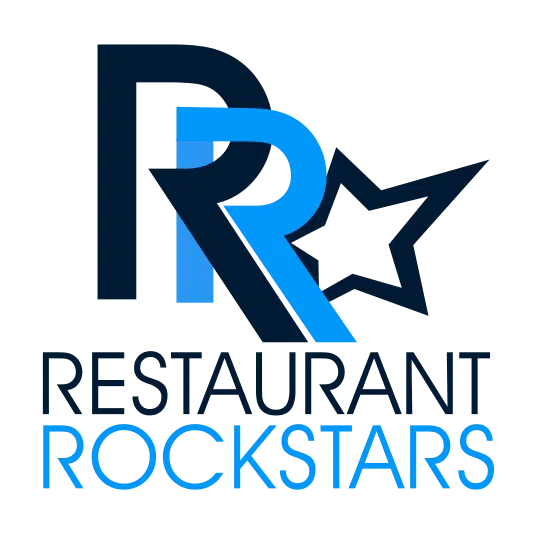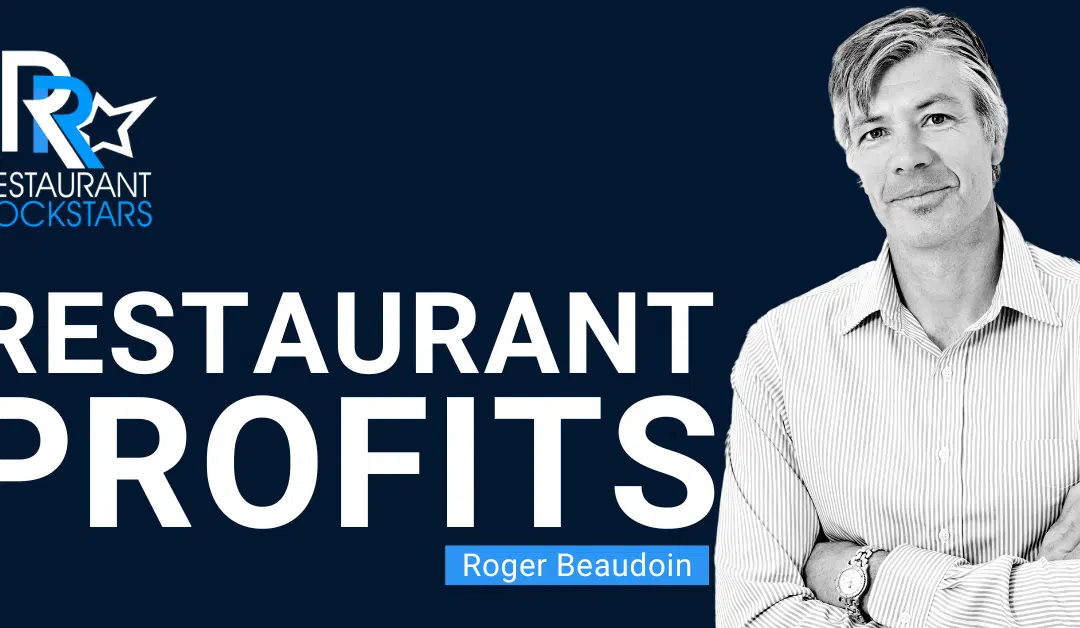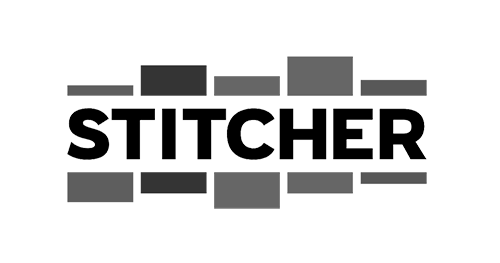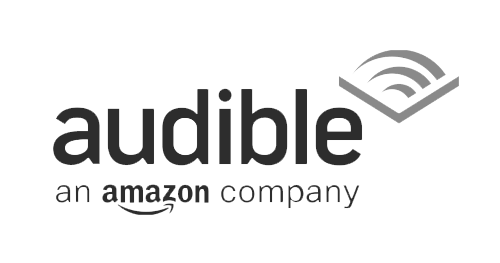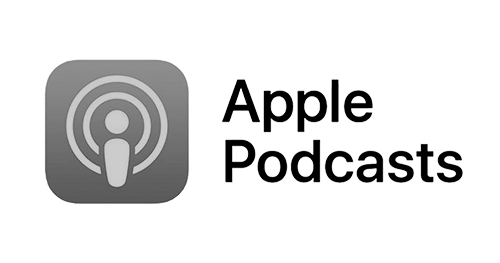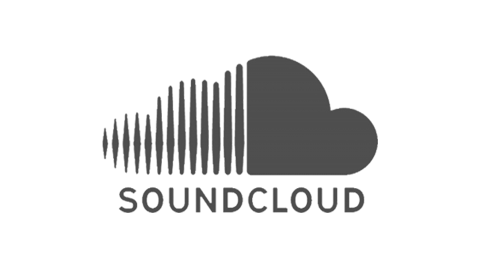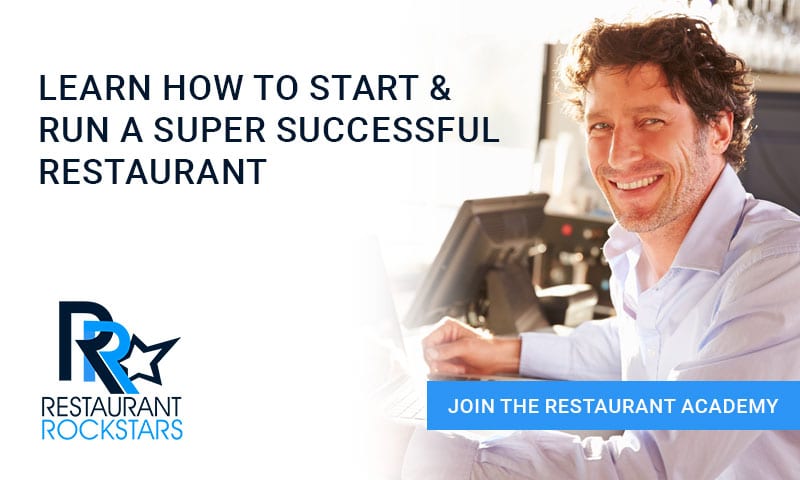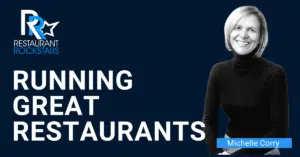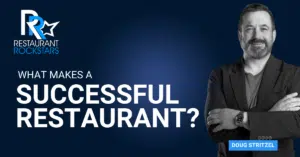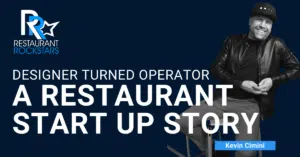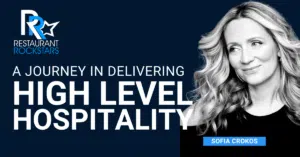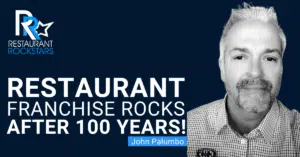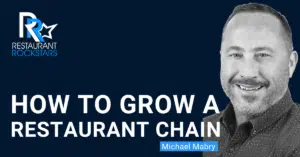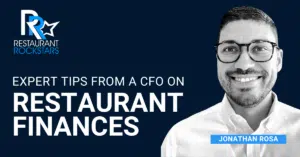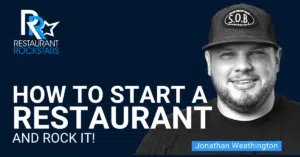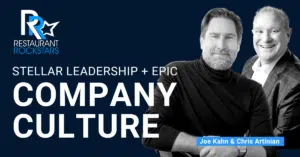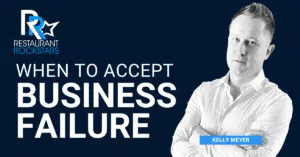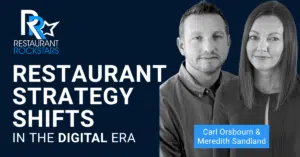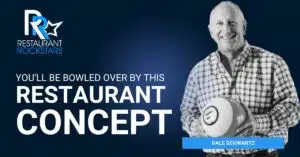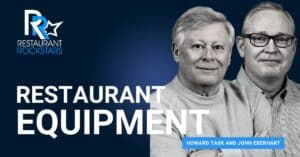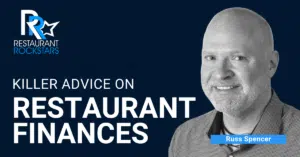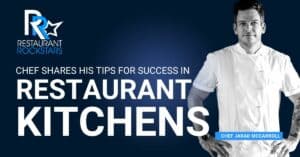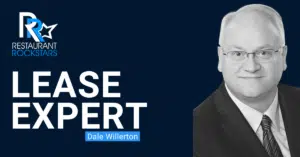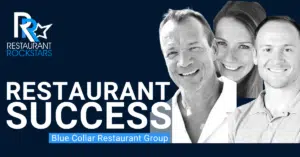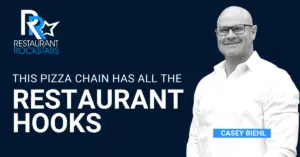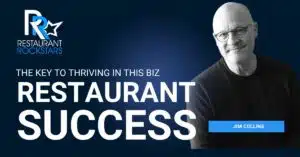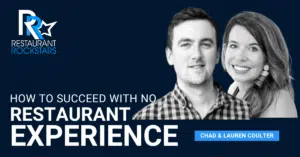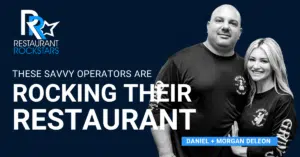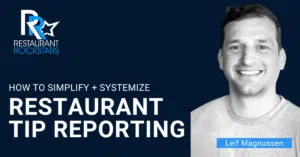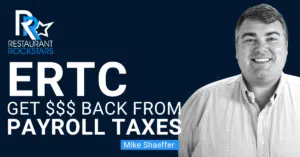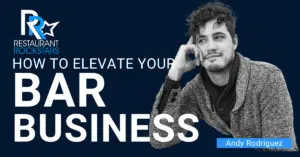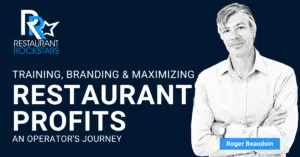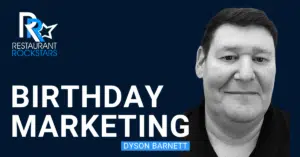Restaurant Rockstars Episode 320
Restaurant Profit –
How to Move the Needle
LISTEN HERE OR ON YOUR FAVORITE PODCAST PLAYER
Prefer to watch the interview?
Click the video below.
When I owned multiple concepts, I was obsessed with my Restaurant Profit.
Now I work with other operators….and I am obsessed with their restaurant profit!
With rising costs beyond your control, there is nothing as important as having a feel for your restaurant’s critical numbers, your restaurant profit or where you might be losing money.
Listen as I tell you:
- The difference between running a restaurant and running a business!
- How knowing your menu item plate cost impacts your financial bottom line
- Why taking Inventory does not mean figuring out your weekly order
- How to set up a simple Inventory system
- Prime Cost and how to make these simple calculations
- How to figure out your Daily Break-Even and which day(s) make the most sense to close
- The benefits of Incentivizing your key-people
And importantly, how to pay for high food and labor costs in your business.
This is a big episode with actionable information and ideas to help you maximize your restaurant profit.
Watch or Listen, then go out there and Rock YOUR Restaurant!
Roger
0:00
Maybe you’d like to spend less time at your restaurant, maybe you’d like to open another location. Maybe you’d like to franchise your business, maybe you’d like to start an entirely different business in a different industry. Or maybe you just like to spend more time with family and friends. These are all different exit strategies. But in order to do that, you’re good people have to have your back. And you need systems in place. But mostly, this is about financial systems. Hey, welcome back. Thanks for being with me. You know, I travel quite a bit and I speak for the industry. I speak at big food shows and different events across the country. I was just in Orlando, and I was speaking about the biggest needle movers in the restaurant business. And those are primarily financial related. So this is kind of a crash course in critical restaurant finances, I decided not to do it not to release an interview with a guest today. But since this is so relevant, right now, in to obviously inflation and rising costs, you really need to maximize profit in your organization. So this episode is me just sort of dishing on what cost controls are what how to maximize the profits. And again, it’s all about the biggest needle movers now and into 2023. So thanks for being with me. It’s going to be an eye opener. Thanks also to the sponsors of this week’s episode Whirks, The birthday club, Smithfield Culinary and SRV the restaurant hospitality training app. Now, on with the episode, stay tuned.
1:27
You’re tuned in to the restaurant rockstars podcast powerful ideas to rock your restaurant. Here’s your host, Roger Beaudoin.
1:42
restaurant owners and managers, listen, this is important. If you haven’t heard of the employer retention credit, your business can receive lots of money back from the IRS money you’ve already paid in payroll taxes. Now the ERC program as it’s known is available. If your operation had fewer than 500 employees, you had to shut down or partially suspend your business or you had at least a 20% reduction in business due to COVID 19 in any quarter of 2020 in the first three quarters of 2021. Yeah, how much is the credit up to $7,000 back per employee per quarter for 2021 and up to $5,000 per employee in 2020. Listen, if you have 10 employees today and meet the requirements you could receive up to $260,000 back in a refundable tax credit. Now the faster you apply, the faster you get the cash, think of it as found money that you can use for any purpose payroll cost of goods, business improvement or other business expenses. Again, best of all, you do not need to pay this money back now works as a company that will do all the heavy lifting for you and get your business back the money that’s due. I’m speaking from experience here with works I received a sizable amount back in all available quarters for my former restaurant and I couldn’t be more pleased with their service their people and their process for a no obligation konsult Click the link for works in the show notes to this episode. Don’t miss out. Get your consult today.
Get everything you need for your operation with Smithfield culinary. Their extensive portfolio lets you serve up a wide variety of proteins to keep your patrons happy. Choose from smokin fast which lets you add barbecue to your menu without adding a pitmaster to your payroll or browse their Margarita offerings encompassing everything you need for pizza toppings, plus a variety of specialty Italian meats like capicola prosciutto and salami. Finally, serve what you love with Smithfield, which includes everything from bacon, to hotdogs to deli meats and so much more for the products and solutions to keep your operation running strong. Visit Smithfieldculinary.com.
All right, everyone, now that I’ve got your attention, this is all about the biggest needle movers affecting your business from a financial standpoint today. And things you really need to think about to put your business in its best position for 2023. So let’s talk what is a needle mover? So when I think a needle movers, it’s literally about profit, it’s like how do we maximize the profit of our business? How do we cut our costs and keep everything you know, moving forward in a positive direction? So I coach with clients, you know, on a limited basis, but when I do, I ask them a question, What business are you in? And what are you selling? Now, this isn’t a trick question. But most of the time, as you can imagine, the answer I hear is, oh, I’m a restaurant owner or a manager and I sell food and drink. And I stopped them right there. And I say, you know, when I was in this business, I was not in the business of running a restaurant. I was in the business of running a business. And those are two different things. And my products weren’t food and drink. They were entertainment consistency, and a whole lot of good times and that made all the difference. For me. That’s kind of a paradigm shift, isn’t it? So think about that. run a business, don’t run a restaurant, build a brand, don’t run a restaurant. So that’s just advice that I give a lot of my coaching clients. So the truth is, many restaurants, those I’ve coached those I talked to, and I travel the country quite a bit, I see that many restaurants are losing lots of money every single day simply because they don’t have systems in place. Now, there are key systems that I call an exit strategy for your business. What does that mean? Well, exit strategy means different things, of course, to different people. But maybe you’d like to spend less time at your restaurant, maybe you’d like to open another location, maybe you’d like to franchise your business, maybe you’d like to start an entirely different business in a different industry. Or maybe you just like to spend more time with family and friends. These are all different exit strategies. But in order to do that, you’re good people have to have your back. And you need systems in place. But mostly, this is about financial systems. So it’s a fact that menus are not designed to maximize profit. Now the menu is something that every restaurant has, it’s your biggest marketing tool. But when we talk about menus, you’ve probably heard that it’s all about menu design. Well, what does that mean? Well, your eye naturally goes to the top right corner, the menu first, and then it goes to the bottom left corner. Well, that’s kind of missing the point, because it’s really about the profit that each menu item in every category delivers to your bottom line. It’s not about necessarily where you place things, but I’ll get to that more in a minute. But let’s just assume that many, many, many menus are not designed to maximize profit. And also, I see that financial control systems are lacking inventory prime costs daily breakeven, do these terms mean anything too? Well, we’re going to cover them in detail. I also ask a question, have you costed out your menu, do you know your profit item by item in each category? Now, when I asked restaurants about this, they can all tell me what sells? What’s the most popular items, oh, this flies out of the kitchen, or my guests would absolutely kill me if I took that off the menu. But then when I asked Well, which items are the most profitable, in more cases than not, you see them suddenly their gears start grinding to a halt, and they kind of scratch their head. And they can’t really tell me this? Well, it all starts with costing out your menu item by item. What does that mean? It means every single ingredient that goes on every single plate, if it’s in service dining, or if it’s takeout, or at a drive thru or over the food truck, or whatever it is, everything has a cost associated with it, all the ingredients combined cost a certain amount of money. And when they add up, then that is your plate cost for the item. If you have a takeout operation, then obviously you need to include the takeout container or the pizza box or whatever it is, because that’s a cost to serve that customer. Now, a lot of restaurants don’t do this or haven’t done this in a while. And let’s face it, it’s inflation. Rising costs are beyond your control. And what can you do maximize profit of your menu. Because if you can’t control the price, you pay for food, you can only raise your prices so much before the value proposition to your guests is lost. And they no longer see the value in paying X amount of dollars for that dish, especially when they’ve been used to paying, you know so much for it for so long. And then all of a sudden, it’s several dollar jump. You know, they’re they’re seeing the same thing in the supermarket and at the gas pump. But when they go out to dinner, they suddenly get sticker shock when they don’t see the value anymore. All the more reason that you have to maximize the profit on every item, especially if you have consistently raised prices. But it really begins with costing out your menu. So what do you do? So if you work with suppliers, whether it’s a big broad line supplier, maybe you work with performance, you know foods, maybe you work with Sysco or US foods, or whoever it is, you’re whoever you buy from, you’re gonna get what is called an order guide. Now an order guide, you have to ask for it from your sales rep or your account manager. But in order to guide literally lists every single item that you buy from that distributor and how much you pay for it and how it comes in to your location. Same thing with the invoices. If you’ve ever taken a really close look at the invoices, it shows you every item that you buy food related beverage related all those things, and then how it comes in. Does it come in in the number 10? Can does it come in in a case of six number 10 CANS is that a side of beef? Is that a block of cheese you get the idea? And it lists the prices per the volume that it comes in. And now there’s a little homework involved, certainly, but you’ve got the basic starting point you’ve got the cost and how much you get for that cost. And now you need to figure out or your kitchen manager or your chef needs to figure out or your general manager or you need to break down every single recipe in your restaurant for every item across categories whether it be an appetizer or or a soup or a salad or a sandwich or an entree or dessert, you need to figure out what the cost is usually per unit or per ounce, okay, of every single dish that goes in to every single recipe, okay, that’s, that’s the basic idea. So let’s just say you have one cost sheet, maybe it’s for, you know, an entree, it will list every ingredient, of course, the cost per ounce. And then obviously, I have a spreadsheet, obviously, that automatically calculates this. But you can do this with a, you know, pen and pencil and calculator and all that sort of thing. But your plate cost is the sum total of every single ingredient, and how much you buy it that goes into each menu item. And literally, it adds it all up, and then you’re gonna get a plate cost total, let’s just, let’s just assume it’s a pizza. And let’s just assume it costs you $2.80 To make that pizza, okay, you’ve got a cost for the dough, you’ve got a cost for the cheese, you’ve got a cost for the sauce, you’ve got a cost for any other toppings that go on it, whether it’s pepperoni, or hamburger, onion, or whatever it is, okay, you’ve broken all this out. And then of course, if it goes out the door for takeout, then there’s the cost of the box, let’s just assume all of those things add up to $2.80, then let’s assume that your menu cost or the price you charge, your customer is $18. Your food cost is 16%. How do we calculate that it’s very simple. You divide the $2.80 cent plate cost by the menu price of $18. And it gives you 16%. What’s the profit, that’s simple. Also, you subtract the $2.80 cent plate cost from the price, you charge the customer of 18. So it’s $18 minus $2.80. And now you’ve got a profit for that pizza of $15.20. Okay, it’s that simple. You need this for every single item in your restaurant, whether you have your kitchen manager, do it your general manager, if you’re interested in this spreadsheet, obviously, we sell a complete package of financial system at restaurant rockstars.com. It’s all there. But essentially, I’m trying to teach you how to do this. But it’s vitally important today more than ever, that you cost out every item. And you know what it costs you to serve every single item to the guest. Why is that? Because with rising costs that change all the time, you could be selling items that are really, really popular on your menu, and you could be losing lots of money by selling this item versus another item in the same category. More on this in a moment. So let’s just assume and I like to use that word a lot, because I do see it so often that chances are your menu just isn’t profitable. Maybe your menu was designed for variety and appeal to the customer. Sure, that’s very, very important. But profits are all over the place. And you wouldn’t know unless you do this exercise or have me do it for you. My most recent client does $2.8 million, roughly in a single location restaurant, which is nice volume. And I found out in the past year that they left a potential profit of about $343,000 on the table simply because in every single menu category, the lower profit items are more popular and bigger sellers than the most profitable items. And every time they sell this appetizer versus that they’re losing several dollars every time they sell this entree versus the most profitable entree, they’re losing many more dollars. So imagine, on a menu, you’ve got appetizers, you might have maybe five appetizers, and maybe one of them contributes a $3 profit and another contributes, say a 450 profit and other one contributes a 525 profit. But maybe the $3 profit item is your biggest seller. And every time you’re selling that appetizer versus the $6, or the 550 profit or whatever, you’re losing that 234 dollars every time. And that’s the eye opener, but it’s even bigger on the entree side because I see restaurants losing 567 10 $11 Every time they sell a lower profit item that’s taking sales away from a higher profit item. So what I’m trying to say is the bottom line is it is very possible to design a menu where every single item in each different category contributes a very similar profit. And the profit difference or spread I like to call it is pennies and not dollars. It’s perfectly fine to have a difference of say 50 or 60 or 75 cents difference in an appetizer, say 80 or 90 cents difference on an entree, but you can’t afford to be losing many, many dollars every time this sells versus that. Okay, so again, I have a template that works all this out. I do coach with certain clients on a limited basis and what an eye opener it is. So just know that this is this is really what menu engineering is all about. So what do you do? Once you find out once you’ve costed out your entire menu and let’s just say you figure out in each category in descending order from most to least profitable, you know what’s really selling, then you can rank those things in terms of profitability. And then you go to a point of sale system, of course, it can print out what they call a sales report or a product mix report, it’s called different things with different systems. But that’s available to you. And as long as you you know, have a lot of data to work with, it gives you that very telling information when I mean a lot of data is it’s great if you change your menu maybe once a year, and you go back and you plug in a whole year’s worth of data. Or even if you change your menu twice a year, and you plug in six months, you still have at least six months of data. A product mix or a sales report tells you the volume of sales of every single item you sold, and how much you charged for it. So I simply transfer that information to this template or to the cost sheets, and then you can clearly see which items are the most profitable to least profitable. And then you can kind of see the volume of sales. And that’s how you can see if you’re making or losing money on a daily basis. But again, I’ve got the automatic spreadsheets that automatically calculate that, if you’re interested, you can reach out to me Roger, our OG er at restaurant rockstars.com. But let’s get back to what to do once you have all this information. First of all, it’s really important with the labor shortage to simplify menus, you clearly can’t have extensive menus these days when restaurants have to close days and you know, even certain days or you know, two days a week, three days a week, some restaurants I’m seeing have to close. So limited hours limited days open, you can’t have an extensive menu with limited people making it. So you got to figure out which items to drop. So let’s just say you’ve got a very popular item that’s not very profitable, that tells me that the market will bear a higher price. And you can raise the price significantly to get it closer to those more profitable items. Or if something just doesn’t sell very much. And it’s on the menu anyway. And it’s taking people’s time to make it but you can’t raise the price and you can’t increase the profitability of it, drop it entirely. That’s one way of simplifying the menu, but you really need to zero in on what’s popular, what’s selling, and then figure out how to maximize the profit of that. Portion controls. I can’t emphasize strongly enough, you know, I go into certain restaurants when I work with them. And I asked them what their portion control strategy is or steps and well, we don’t have one. So then I go out on the line. And I kind of watch different people making the same things. And let’s just say it’s a pizza restaurant. And I noticed one person putting 10 pieces of pepperoni on a dish. And then I go in watch someone else making this very same pizza the same size and other putting 12 or 14 pieces on it and it’s inconsistent. And I asked the owner, the general manager, so what is the recipe call for and they say, Well, I think it’s supposed to be 10 pieces of pepperoni. And I say okay, well every time this person is making it, it’s 12 pieces every time that person’s making it, it’s 14. But I did see one person putting 10. So every time you’re selling a pizza, that means you’re losing two or four pieces of pepperoni when these other people are making it, there’s no consistency there, you need a recipe card with a photograph of what the presentation should look like. It should point out all the ingredients, and exactly what quantities of those ingredients are. And then you need a check and balance system where you watch, you have somebody else watching and you make sure that there’s consistency. Maybe if we’re talking about a pizza operation, you’ve got a big bin of cheese there, you need a portion control cup, not just taking rubber gloves, and you stick your hand in the bucket of cheese and you just put the cheese on the pizza. You know you’re buying so much cheese in a in a restaurant, or so much pepperoni or whatever ingredients we’re talking about, you need those portion controls. That’s super important. Let’s talk about ingredient choices. Now I mentioned earlier, some of the bigger broad line suppliers that you might work with, you know, you have a sales rep or an account manager, that very knowledgeable person I always used to ask, you know, you know what I’m buying now, what can I use as a substitution? Is there anything where the quality is the same, the guest won’t notice a difference in the flavor profile yet you bought it in much larger quantity, you got a better price on it. So maybe I can lower my food costs on that item by switching ingredients even though it’s the same item, okay? It’s it’s a different brand perhaps, but the quality is comparable, but you got it in greater volume so I can get a better price. You don’t ask you don’t get I always used to do that. That’s super important. I would always sample those products in advance to make sure that the flavor and the quality is there, but chances are and over the years I switched products numerous times saving a lot of money on my food cost and the guest was happy and I was obviously more than happy. Okay, let’s just go back to the cost sheets. Now if you’ve costed out your menu and you know which items in each category are the most profitable. I always used to train my staff to suggest those items you know pick to favorites in appetizers and entrees and desserts but make sure that the most profitable And then recommend them every table every time. And that’s going to increase your profit of those items. cash cows, okay, you cannot have too many cash cows, what’s a cash cow, it’s an item that contributes a lot of profit with very high perceived value, yet it costs virtually nothing to serve. What does that mean? perceived value is, I call it wow factor when I ran restaurants, you know, you put a plate in front of a guest. And they look at it, and they say, Wow, to the rest of the table, and then it looks so nice. They don’t even want to cut into it, they want to take a picture of it first, you know, and maybe that gets posted to social media. I mean, that’s marketing, of course, but you get the idea, high perceived value, wow, factor, it looks great. It smells great. It tastes great. Yet, it costs you very little to put on the plate in terms of what you charge for it. So it’s pure profit. Okay, we have to raise prices, chances are, you’re already done. So you have to write you have to keep up with increasing costs by raising prices. But again, I’ve already emphasized that it’s more important to identify which items are the most profitable to sell, cut the low profit items or raise prices on those and really dial in your menu. Okay, communication is so important. You know, so many people will raise prices on their menu and not make any mention of it to the guests. And you really have to be authentic and honest, you have to tell people, you really appreciate their business, thank you for coming in. You know, these are difficult times, we’ve just gone through the pandemic, and now it’s a labor crisis. And we have to pay more for labor than ever before those rising costs, whatever it is, you know, we have to pass certain costs on because it costs us more to serve. Thank you so much, you know, that sort of thing. We did a lot of that when I had my restaurant that I bought, just before the pandemic, we had to communicate with customers and every takeout order, there was a thank you note, all those things are super important. Now go back to the drawing board, this is what takes a little bit more time you’re stopping the bleeding, right? You just train your staff to recommend the most profitable items. Maybe you do a simple menu reprint right now, where you highlight or you box those most profitable items in you call attention to them in some way. You call them guest favorites, or most popular, whatever it is. And now that’s drawing the guests attention to those items. And hopefully, you’re going to sell more of those by the server, or the staff recommending them and the guests seeing them called out on the menu. And then you go back to the drawing board, you work with your chef, you work with your kitchen manager and you redesign the menu you pare down the items that you don’t need to have cross utilization of ingredients is super important. That means you don’t bring in one or two ingredients that literally go on one or two dishes, you want to bring in ingredients that go across multiple dishes. So that that minimizes waste and spoilage and all that sort of thing. And that maximizes your profit. But then you redesign or I should say you re engineer your menu where everything contributes a similar profit where that spread difference now is pennies, and not dollars I mentioned in appetizers, you know, 50 or 60 cents here, they’re fine. On entrees at 90 cents here they are fine, but you don’t want to be losing dollars. So that’s the key to menu engineering. You would not believe how many restaurants that I talk to, or even hear about in working with key suppliers in the industry that think that inventory is walking around figuring out what the order is that week. No, that’s not what it means. Okay, taking inventory is calculating the true value of your goods on hand at any given moment. That’s your quantity of food and your quantity of beverages. Okay, that’s super important. And it’s a system. Again, I have a spreadsheet for this. But imagine you’re starting inventory for the first time. And you take in products every week, maybe from one major supplier, maybe from several suppliers, and you’ve got things stocked on shelves in multiple places, you’ve got a walk in, you’ve got a freezer, maybe several of these, you’ve got small sandwich fridges, you’ve got stored dry storage shelves, all these things are places to store food. When you’re first taking inventory, you need to arrange things on the shelves where it never changes. Maybe those shelves are labeled where whoever puts the food away always puts it away in the same place every single time. That’s super important. And let’s just say that that is constant and it doesn’t change. Now you need to make a note of every single ingredient that you buy. And obviously how it comes into your organization. Does it come in by the case? What’s the price for case again, yes, this takes a little bit of homework. And that’s where you know the templates that we have come into play. But let’s just say to make inventory as least painful as possible, because you’re going to be counting this at least for the first couple of weeks before you go to a 30 day system. I’ll talk more about this in a moment. You need to arrange things on a spreadsheet or on a tracking system in the order that you would count it. So let’s just say you walk into your dry storage room first. And you very methodically list the items as they appear on say the shelves maybe you’ve got one shelf down the side of the left wall and then there’s one shelf a shelving unit In the middle of the room, and then maybe there’s a shelf on the back wall and on the right wall. So when you’re taking the counts themselves, you’re going to walk around methodically in the dry storage area, maybe you start on the left side wall, and you count from the top to the bottom on a shelf. And then you move a little bit further and top to bottom, top to bottom, then you go around the back wall, and then you count those items, then down the middle, on the left side on the right side. And then finally, the right wall. Same thing with your walk in cooler, however, things are obviously arranged, that’s how you want to count them. And that’s how every item that you buy should appear on your tracking system or your spreadsheet. Okay, so it’s very important to have a detailed description of what the item is, and maybe it’s diced tomatoes, maybe it’s chicken breast filets, maybe it’s tomato sauce, or pumpkin pie mix, whatever it is, wherever you store it, it has to be listed, obviously as the item. And then how it comes in your organization, does it come in by the case the individual can? And then what do you pay for that case? Or what do you pay for that unit, this is where it’s so important to accurately record the price of each item and how it comes in. Because if you’ve got a spreadsheet template, maybe it’s an Excel spreadsheet, it’s got a formula that’s going to automatically calculate the cost per unit times what you count what you have in stock in any given moment, maybe you’ve got, you know, four cases of chicken breast and each case cost $62. When you type in four into the spreadsheet, at $62 a case, it’s going to automatically calculate that the value of that chicken is $248. And then at the very bottom of your entire spreadsheet, when you’ve literally entered every single item that you buy, and where it’s stored, whether it’s in your walk in cooler your freezer, your dry storage area, it’s going to automatically calculate the total of each of those storage places. And then the bottom line is going to tell you what the inventory total is, at any given point in time after you’ve taken the count. Let’s talk about Pars, because par is very important. There are things that in your restaurant that are very difficult or inaccurate to count. So it’s important to just assign a value that never changes. Let’s use spices because spices are a good example. Or even prepared sauces, maybe in a five gallon pot, perhaps. Okay, so over time, it’s going to average out to be the value of what you assign it to. So let’s just say you’ve got, you know, a whole shelf full of spices, and there’s little spice jars, and there’s maybe the bigger tubs of spices, let’s just say that it’s worth $400 At any given time, that is automatically plugged into your inventory sheet and it never changes because over time, it’s going to average out to be about $400. And that’s about as accurate as you can get it the same for prepared soups. And the same for maybe you’ve got a sandwich cooler with cold cuts, and cheeses and meats and all that kind of stuff. And it’s just too onerous to count that every single week. So again, you assign a random value that you think is as close to accurate as possible at any given point in time. You call that a par, and then it stays constant on your spreadsheet. Okay, I don’t want to confuse you. But let’s just say you’ve taken the counts, you’ve got everything accurately entered on your inventory spreadsheet, and then it gives you a total, you know, at the very bottom. So why is it important to take it I recommend you take an end a physical inventory count of food and beverage every single week for three, if not four weeks, why is that? Let’s just say the very first week you take inventory, and maybe you’ve got a value of $2,000. And then you calculate your food cost on that. And maybe you get a you know, maybe you get a 30% food cost and you’re happy with that. And you’re, I’m on my way, that’s great. And then you take inventory the second week, and now you get a 33% food cost. And then you take it the third week in a row. And now it’s a 28 You don’t know what your food cost is because there’s no consistency there. But if you were to take your food cost and your inventory calculation three weeks in a row, and let’s just say the first week, he got to 30. And then the next week, he got to 30 and a half. And then the next week he got to, you know, a 30. Again, that’s your sweet spot 30 You got consistency there. When that happens when you get to a point three or four weeks in a row where you’ve got the same or very similar number. That’s your sweet spot. And that’s where you want to stay. And then you can go to a 30 day calculation, because let’s face it, this process takes a little bit of time. But it’s critically important to know and not wait 30 days to find out. Oh, my food cost is a 36% when I want it to be a 30 and now you got to figure out what happened oh cases steaks has been walking out the door every other day because you know someone’s selling the steaks out the back of their car to make extra money for whatever reason it happens. I’m speaking from experience when I say this, okay, when you’ve got your sweet spot and you hit that 30 a 30 and a half several weeks in a row then you can go to a 30 day inventory. And as long as your sweet spot and your food cost stays at 30 or 30 and a half every month 30 days later, then you’re in good shape. Okay, that’s In the inventory process, the same goes for beverages. Okay, again, you’ve got different storage areas. If you have a full bar, you’ve got liquor cabinets that store liquor, you might have a walk in cooler if you’re selling keg beer, you might have a stand up refrigerator that holds bottled beer, or chilled wines, you might have a storage area that has red wines, all these things. And then there are pars for that as well. If you’re selling draught beer, you have co2 or gas containers that you get from your gas company, those have a value, you know, soda bibs that are called if you work with Coke or Pepsi, you’ve got those boxes that sit on the shelf that sell obviously, and mix the the sodas, all of those things have values. And of course, those have value. And then you’ve got fruit, and you’ve got mixers and all those things, and you’re not going to count what that is. So you have to come up with that par value for each of these items. And again, everything fits on a spreadsheet, how does it come into your location, if it’s a liquor bottle, is it a 7.75 liter bottle is that a 1.5 liter bottle, you get the idea kegs come in quarters or half barrels or whatever, obviously, you have to take the counts on those, and then bottles of wine, all those things. So again, this, how you store it, and how it’s easier, methodical to count it is super important. And then when everything is plugged in how it comes in how much you pay for it, and then it automatically calculates a total. That’s the very first step in the inventory process. The next step, there’s a whole different spreadsheet that restaurants use to calculate the food or beverage costs. All right, I don’t want to complicate things any more than they are. But there is a formula for let’s just say food or beverage cost and the formula is this beginning inventory plus purchases, minus ending inventory equals what is called usage. Now what is usage, a lot of people confuse this usage is everything that you sold to a customer, you sold to staff at a discount, you threw in the trash because it was spoiled or wasted, or you comp to a guest because they didn’t like it and you had to take it off their check, or it walked out the back door because somebody stole it that is your true food or beverage cost all those things combined. Okay. So again, beginning inventory plus purchases, minus ending inventory equals usage, and then divided by sales, gives you your food or beverage cost percentage. Now, it’s really important to start at the beginning, what is beginning inventory. Beginning inventory is the very first time that you actually put that spreadsheet together, you walked around, you took the physical counts, and the spreadsheet told you that you had say $5,345 in inventory in food sitting in your walk in signal, dry storage, wherever you store it, then that that week, after you take the count, you might have several vendors. So you make a list of all the different vendors and the dates that you brought food or beverage into your location, I have to emphasize that it’s really important not to confuse what isn’t food, I can’t tell you how many restaurants have included drinking straws and rubber gloves and mop heads and all these things that are not food items when they count things. And then that artificially skews their food cost. And they suddenly wonder, Well, why is my food cost 50%? Well, because you’re counting things that aren’t food, okay, and all that sort of thing, and it just throws everything off. So accuracy, again is very important. What’s your ending inventory, I told you, it’s important to take inventory several weeks in a row until you find your sweet spot, your ending inventory is the very next week that you counted again. So your beginning inventory is the first time you did it. And then the ending inventory is one week later, when you take it again and you plug these numbers into the spreadsheet. Now this is very important to emphasize that you always take your counts your physical inventory count on the same day each week and around the same time. But let me explain. Let’s just say you want this process to be as easy as possible. Therefore, you want to take it when your inventory levels are at their absolute lowest well when is that for most restaurants usually it’s the end of a busy weekend because Fridays and Saturdays are the busiest days. So by Sunday afternoon or Sunday night when you close your business, your inventory on the shelves or in your Watkins or wherever you keep stuff should be at its lowest level until you start taking in deliveries again Monday through Friday. So I recommend you take well, maybe you’re a little burnt out on Sunday after working all weekend to take it Sunday night. But that means you really should take your inventory Monday morning when you’re fresh early enough before any of the delivery trucks start coming in. Because you don’t want to confuse what’s already on the shelf versus you know, the delivery driver walks in and out new stuff starts being put on the shelves, obviously while you’re trying to count what was already there. So I emphasize that it’s really important to take it before the purchases come in the door. Then On the spreadsheet, again, you’re making a note of every single food purchase that comes in from different vendors, that’s your purchases. And then your ending ending inventory is one week later on a Monday morning, before stuff comes in the door again, you take that physical count again, and that’s when you plug in the ending inventory. So once again, the formula beginning inventory, plus all your purchases for the week gives you a total, and then you subtract your ending inventory from that. And that’s what gives you that number of usage, which I already explained. Now you divide it by food or beverage sales only, okay, and that’s not total sales. If this is a food inventory, you’re trying to calculate food costs, you’re gonna divide by food sales over that date range of that week, I have to emphasize that importance. One more time. Also, the date range is important. So let’s just assume that you take your inventory Monday morning, you’re gonna count food sales Monday night, Tuesday night, Wednesday night, Thursday night, Friday night, Saturday night, and Sunday night, but not the following Monday. Okay, so literally, you’re counting Monday, Tuesday, Wednesday, Thursday, Friday, Saturday, Sunday, seven days of sales before you count it again. And then you plug in, say $10,000 of sales. This is just for hypothetical reasons. Of course, you’ve got your beginning inventory of $5,345. Okay, your purchases total 2145, those get added together, that gives you a total of 7490. Your ending inventory one week later, is $4,000. Say, then your usage is $3,400. And now you’re going to divide by $10,000 in sales, and that’s going to give you a food cost of 34.6%. Okay, again, I’ve got the templates for this, I’ve got the audio tutorials that explain how to do this. But this is just for illustration purposes. This is how you take and calculate your food or beverage costs super important stuff. Let’s talk about labor. There’s also a sweet spot. And I always used to calculate my labor cost every single week. Now there’s a total labor, which is everybody that works in your place that’s kitchen, that’s front of house, back of house managers yourself if you take a salary or any kind of pay. And then there’s kitchen labor, which is your most expensive labor, these are crazy times, I don’t need to tell you that, you know, you’re paying cooks more than you ever have before. And I always used to track kitchen labor against sales, because again, your servers are low cost labor, if you have a tip credit in your state, and obviously, you’re able to pay them less than the minimum wage because they’re tipped employees. So I never used to track that. I tracked efficiency of scheduling, that’s super important. I staggered people on the schedules that I didn’t bring in like two hosts, right away at the same time and only need one I had a really good feel for when my business got busy and how many people I needed to have. And you probably have that feel for your business too. But let’s go back to a labor cost analysis, it’s really important to track your total payroll versus sales every single week. And then your kitchen payroll versus sales. So there’s a sweet spot here as well. Let’s just assume one week, your total sales was $54,000. That’s nice, right? And your labor against that is 14,600. That’s a 27% payroll cost, that’s pretty solid. On the kitchen side, let’s just assume your sales were 22,000. And your labor and kitchen was 7000. Much higher, right? That’s a 32%.
So let’s just say two weeks later, you have very comparable sales, you had $54,100, perhaps in sales, overall, you had $13,855 in labor, which was less than what I just said. And now you do the math in the spreadsheet calculates a 26% cost. And that’s one point lower overall, but in the kitchen, this is great, right? 21,900 and sales, food sales only, of course, again, 6850 and labor in the kitchen. And now that’s a 31%. So you dropped a point in overall and you dropped a point. Obviously in the kitchen, one point every single week over time, saves you a whole lot of money. So now you’ve got a benchmark, I call that the sweet spot. And you investigate you ask your managers or maybe you were there and you watched where the guests happy. Were there any glitches did I have the optimum number of staff to serve the optimum number of customers that come in and over time you’re you know, usually your Tuesdays are similar to your Saturday, not? Well, your Tuesdays each week are similar your Saturdays each week similar and when you get a feel for your business like that, and then you dial in your payroll so that you know it’s possible to achieve, say a 26% overall payroll and then a 31% overall kitchen payroll. Now you can compare when suddenly it goes to you know, 28% or 33%. You’re like well what happened because I know I can do better and then you investigate further. So again, we have spreadsheets that will let you dial in your labor in Every position in the kitchen and all that sort of thing. So you can really focus on if you find that you’ve got a labor problem, you can isolate the problem, and you can solve it and fix it. You know, it sounds like homework. But again, the spreadsheets are there, the tutorials are there. And we give you the system so that you can save yourself lots of money. And this was this is what cost controls and maximizing profit is all about. And that’s why this is about needle movers. Let’s talk about a time change authorization. And well, what does that mean? Let’s just say a long time ago, you know, I recognized that there were labor abuses in my business. What does that mean? Well, you know, I would do payroll myself, I wouldn’t process the payroll, I had a payroll processor, but I would literally go to the point of sale system for a couple of years. And I would print out, obviously, the payroll reports. And then I started to notice that people were punching in early, I had 55 employees in my biggest restaurant. And I noticed that over time, you know, I had at least 30 or 32, out of those 55 employees that would punch in anywhere from five to 18 minutes early, consistently. And I wondered why that was. And yes, there are legitimate times when a manager, or we call our people in earlier than what the schedule says, for legitimate reasons. But in this case, it was not legitimate. And I started to watch and of these people they’d come in, and what do people do the very first thing when they walk into your restaurant, they punch in most mostly they go to your point of sale system, they enter their number, and they clock in, right, that’s the very first thing anybody does. And then I watched, and then they would go hang up their coat and hang up their purse. And then some people would go to the bathroom, and then they go to the bar, and they pour themselves a soda, and then they chit chat with their friends. And maybe the schedule said they were supposed to be there at 4pm. But they showed up at quarter to four, and they clock in at quarter to four. And now they’re doing all this stuff, and they’re not doing anything productive. And I realized that this is costing me 1000s of dollars over time in per month, really, because I had 55 employees. And if you got 30 people punching in 1015 minutes early here and there, and it’s not productive time, it’s costing your business a lot of money. So I set up a system. And I made it very clear to people that I noticed this was happening. And I said, you know this is probably seemingly innocent for you. But if it’s not productive time, and if you’re not working, it’s costing us a lot of money. And we had recognition and rewards programs and lots of incentives. And we took really good care of our people, and we paid them well. But I had to explain that, you know this, I just can’t afford to pay for time that you’re not actually working. So I said very clearly, if the schedule says you’re supposed to be here at four o’clock, I want you to punch in at four o’clock. And if there’s not a legitimate reason for you to come in early, then I’m not going to pay you for that time. And please know that any point of sale system that you use has an ability to edit the clock in times. And I told them, okay, here’s a simple spreadsheet, and we hung it up all over the restaurant, it was in back house, it was in front of house. And it simply said, Okay, if if for some reason your manager called you in early, it is your responsibility to put your name on the sheet, the time you were supposed to come in what the schedule said you were supposed to be versus the time you actually punched in what was the reason for coming in early. And then I need your manager sign off, I need to see your managers initial on that spreadsheet. And if your name doesn’t appear on the spreadsheet, I’m not paying you for the time and I’m going to edit that. Okay. So again, we add recognition rewards, we treated our people very well. But I simply explained, you know, we can’t pay people 15 minutes early times 30 people a week. So please punch in when the schedule says you’re supposed to be there. That was important. Let’s talk about daily break, even during these crazy times, when you have to close maybe a day or maybe two, you’re not really sure when it makes sense to close. Okay. And you wouldn’t know that unless you calculated how much it costs you to open the doors to your restaurant every single day. Let’s just say you walk in, you turn the key is to the place you turn the lights on, you bring in your people to serve the guests, you have food in the walkins and all that kind of stuff and you’re ready to go. And whether you serve one person or 100 people or 200 people, it costs you so much just to open those doors. Okay? So we have a calculation called Daily breakeven. Pay attention here. It’s not complicated, but you need to know the difference. Every single restaurant has expenses every single month. You know, you have invoices for food, you have insurances, you have to pay you have all kinds of, you know, expenses and there are two different kinds of costs. You have fixed costs, and you have variable costs. What are the differences? A fixed cost is something that you have to pay whether your restaurant is open or closed. It doesn’t care if you’re open three days a week or seven days a week or closed entirely like you had to during the pandemic. These are things like your rent on the on the building or a mortgage if you own the property insurance, General Liability liquor insurance, doesn’t matter if you’re open or closed. You’re paying these your licenses, your repairs. Your telephone bill internet dumpster out in the parking lot. These are fixed costs that you have to pay open or closed, regardless of how many days you’re open varial Variable Costs vary or go up or down based on your open days or hours, things like payroll, right, if you’re open three days a week, your payroll is a lot less than it is if you’re up and six or seven days a week, cost of goods, same thing, heating, oil, electricity, all those are variable. So whether you have an office manager, or you just have a big file cabinet or you keep things in the cloud, it doesn’t matter, you need to put a list together of every single expense you have every single month. And again, we have a spreadsheet for this. And you literally plug in on a month per basis what all your fixed costs are and all your variable costs, and then the spreadsheet that I have divided by 30. Or you can do this on a pad and pen yourself, you divide by 30. And it might give you a number, it might be $1,200, it might be $900. It’s it’s based on the size of your business, essentially, and what your expenses are. But now you know that any single day if you’re not selling at least $900, which is your break even point, if you’re consistently on a Monday or Tuesday, hitting 675 and sales are 800 and sales, anything less than 900 many weeks in a row, you’re losing money, not making money and you’re not breaking even. And unless you can come up with a special promotion, which I recommend, which will drive business on your slower days. If you can afford to be open. If you have enough labor to serve it, then it makes sense to close on that day. And that’s how you figure it out. So that’s your daily breakeven. Listen, I’m all about marketing. But believe me, very few marketing ideas today are fully trackable where you know exactly where the business is coming from. And you also know that it’s generating a positive return on your investment. Now I no longer own restaurants. But if I did, this idea would be at the very top of my marketing plan. It’s all about birthdays. Everyone has a birthday and they are a huge Let me repeat that huge source of business in your restaurant. Why wouldn’t you want to focus in on reaching everyone with a birthday in your area? Well, you can with a birthday club from fan Connect. Best part is they do everything for you. You get a turnkey marketing system that sends birthday cards in advance, inviting people to celebrate your restaurant from your area code plus a sign up strategy for your existing customers. New business repeat business hire check averages and a massive customer database. You can get all this with the birthday club. Check it out and sign up now at get fan connect.com forward slash birthday Rockstar.
Let’s talk about empowering your management team. Okay empowered managers or leaders I should say grow your brand and your business. I used to always incentivize my my managers or my leaders for key results. Maybe they created a loyalty program, maybe my you know, my host manager increased takeout and delivery, my kitchen manager might have started a catering program or private parties and events. Maybe my GM did that. Or I always used to incentivize my kitchen manager, my bar manager to keep their costs in line their food costs and their beverage costs in line. I incentivize people for that. One of the biggest if you have a draught beer sales program, or if you have a bar that sells draught beer, I certainly recommend starting a mug club because people will pay you a membership fee every single year to belong to the club, you can get this program sponsored, I can teach you how to do that, you know, once again, our academy system teaches all these things the How to Start a mug club. But again, you can bring in significant amounts of money in memberships, just by creating this club and giving value added benefits to your members. And if you do it right, and if you do it well. And if you have it sponsored, there’s absolutely no cost to bringing in the mugs or the T shirts or the value added all you have to do is give people great service. And they’re going to pay you a certain amount of money every year. It could be 50 bucks, it could be 100 bucks, depending on the size of your place. My business started small so many years ago, you know, we started with maybe 25 mugs just to see if we could sell them they sold out in a day or two. So we brought in like 50 more. When I sold that business in 2014. We had 1200 people paying us $50 a year to belong to the club. Now, that was a whole lot of money that was about $60,000 in free and clear cash because it was sponsored. We put the sponsors logo on the mugs and on the T shirts and we promoted them in our business. So there was no cost to me and that was just money that came in the door. All we had to do is give these people great service, but the real kicker wasn’t so much the 60,000 bucks and what business couldn’t benefit from an extra 10,000 5000 20,000 Whatever you’re able to bring in. You can do a whole lot with that you can pay a manager you can do capital improvements, improve your business, whatever it is no the real kicker is we noticed very quickly that people that used to come in two times a month, maybe three times a month, now came in two or three times a week. It was amazing because now we created this club where they felt like you know, they belong to that cheers formula, right? People go where everyone knows their name. And then it grew like coral, everyone recommended to their friends are you gotta join this fun club, you know, this business, and blah, blah, blah, and I go there all the time. And now, they are the best salespeople to sell more mugs. And that’s how you obviously start a mug club. Again, we can teach you how to do that. I used to bonus people for coming up with, you know, off the menu specials, my kitchen manager was incentivized for bringing in more profitable items, or ordering efficiency, whoever does the order, you know, we used to have a meeting, say once a month would bring everybody in. And we’d sit there and brainstorm. And I say no idea is too crazy throw out ideas, we had the big flip charts and the dry erase markers. And I said to people, if you come up with an idea that I can track, if it sounds like a good idea if we try to execute it. And if it either saves money, it’s a more efficient way of doing things or it brings in additional profit. And if I can track the savings or the profit, I’m gonna give you a percentage of that, you know, and we did that. And it was so awesome. And it’s just a great idea. Let’s talk about that. It could be a new marketing idea. It could be a new profit center cost saving idea preventative maintenance. Again, if you can track it, you’ve got to reward your people. And that’s just the best practice. Let’s talk about paying for these higher costs right now, especially labor. Hopefully, if you’ve made it through the pandemic, and you’ve made it through you, it’s been a whole lot of hurt and hard times, of course, but there’s been several programs, hopefully you took advantage of the P, PPS and all that sort of thing. Know that if you applied for something called the restaurant revitalization fund, or the RR F, there’s still and this is not a lot of money, but there’s still $180 million that the SBA needs to distribute, they just announced that if you have applied for it, and if you didn’t get it, then that money is available, and they’re going to dole it out. In some way. It hasn’t been announced how but here’s where it comes in. I’ve always recommended, I’ve always, you know, I learned a long time ago, you don’t ask you don’t get. So I recommend that you belong to your state Restaurant Association, because they got their finger on the pulse of what’s happening, they’re going to be the first to hear about how these funds are going to be distributed. And if you have an SBA office in your state, it behooves you to make friends with that office, have them get to know you and say, Hey, I applied for this RF so long ago, I didn’t get the money, is there any way you can give me a heads up as soon as it’s announced or how I can apply for it. And again, you don’t ask you don’t get and if they know who you are, chances are they’ve got connections, and you might be able to get money that way versus just sitting around waiting for the phone to ring. Here’s the kicker if you haven’t taken advantage of the employee retention tax credit, you absolutely have to do this. The employee retention tax credit is a program sponsored by the Cares Act so long ago, there’s no deadline at this point. But it allows you to get money back for all four quarters of 2020. And the first three quarters of 2021. This is money you’ve already paid in payroll taxes. And it’s it’s it’s a little challenging. I don’t recommend you do this yourself. But please know that there are CPA and accounting firms that are doing this, some payroll companies are doing this, but they will file the paperwork for you. And you will get all those dollars back. It could be up to $26,000 per employee for all those quarters combined. I took advantage of it our business got a lot of money back. And you know, these firms now are charging a recovery fee anywhere from 10 to 20% of what they recover back from you. But I highly recommend because you know if I could get $150,000 back, I pay $15 $15,000 All day long as a percentage as a recovery fee if someone did this for me and get the money back. So just know if you haven’t taken advantage of this now. Find a firm that does this talk to them. I have a firm that is sponsoring our weekly podcast, I can certainly put you in touch with them all you have to do is email me once again Roger, our OG er at restaurant rockstars.com I’d be happy to put you in touch with this firm. And I highly recommend them because they work to get the money back for me. And they’re charging 15% as recovery fee which is more than fair once again, because this could be significant. You could get $200,000 plus back it takes a little bit of time once you apply so I highly recommend you look into that today. Trade I’m a big believer in trade because it costs pennies on the dollar. It’s essentially what your food cost is if you can trade for services, linens or fresh flowers or whatever it is, again, you don’t ask you don’t get versus paying $1 for a dollars worth of value. If you can pay 30 cents on the dollar. It makes sense to trade. Also employee incentives. Why not trade gift cards for Gift Cards. What does that mean? You give a local business, not a restaurant, maybe it’s a tanning salon or a movie theater or whatever the business is a retail store, trade gift cards, give them a handful of gift cards at your restaurant for 20 or $25. And ask for an equal value back and gift cards to that business. And literally for 30 cents on the dollar or whatever it is. Now you’ve got a bunch of prizes, prizes and incentives that you can give to your people for outstanding performance. Again, you got to maximize profit and every sale we already talked about the menu costing thing but you got to be resourceful and turn over every rock. All right. That’s it, folks. Um, I really appreciate you listening to the podcast. If you have any ideas for anything you’d like to see or hear. Please reach out to me once again. My email is Roger@restaurantrockstars.com. I wish you all the luck in 2023 and a more successful more profitable business. I hope this needle movers episode really moves the needle for you. Can’t wait to see you next time. Thanks for listening.
Listen, I am a huge believer that service is your restaurants greatest competitive advantage. But we all know that service takes time and commitment, dedication. Well what if there was a training tool, a single tool that was completely customized to your restaurant brand your menu. Let’s start with photos of the plate presentations, ingredients, romance, notes, allergens, everything that’s important that your staff need to know to present and bring to life your menus for your guests that includes your wine and beer list. specialty cocktails, everything at their fingertips. Imagine in the back of house that cooks your new prep cooks or anyone can instantly look at the photos, elicited ingredients with prep times and cooking steps all the important things to produce each dish to perfection. Imagine there’s also table layouts of every dining space in your restaurant with table numbers and even seat numbers because we all know how important it is to deliver the right dish to the right guest This is a tool designed to enhance hospitality in your restaurant, not replace it. Learn more at surf now.com That’s srvnow.com Check it out.
57:10
Thanks for listening to the restaurant rockstars podcast for lots of great resources, head over to restaurant rockstars.com See you next time.
Transcribed by https://otter.ai
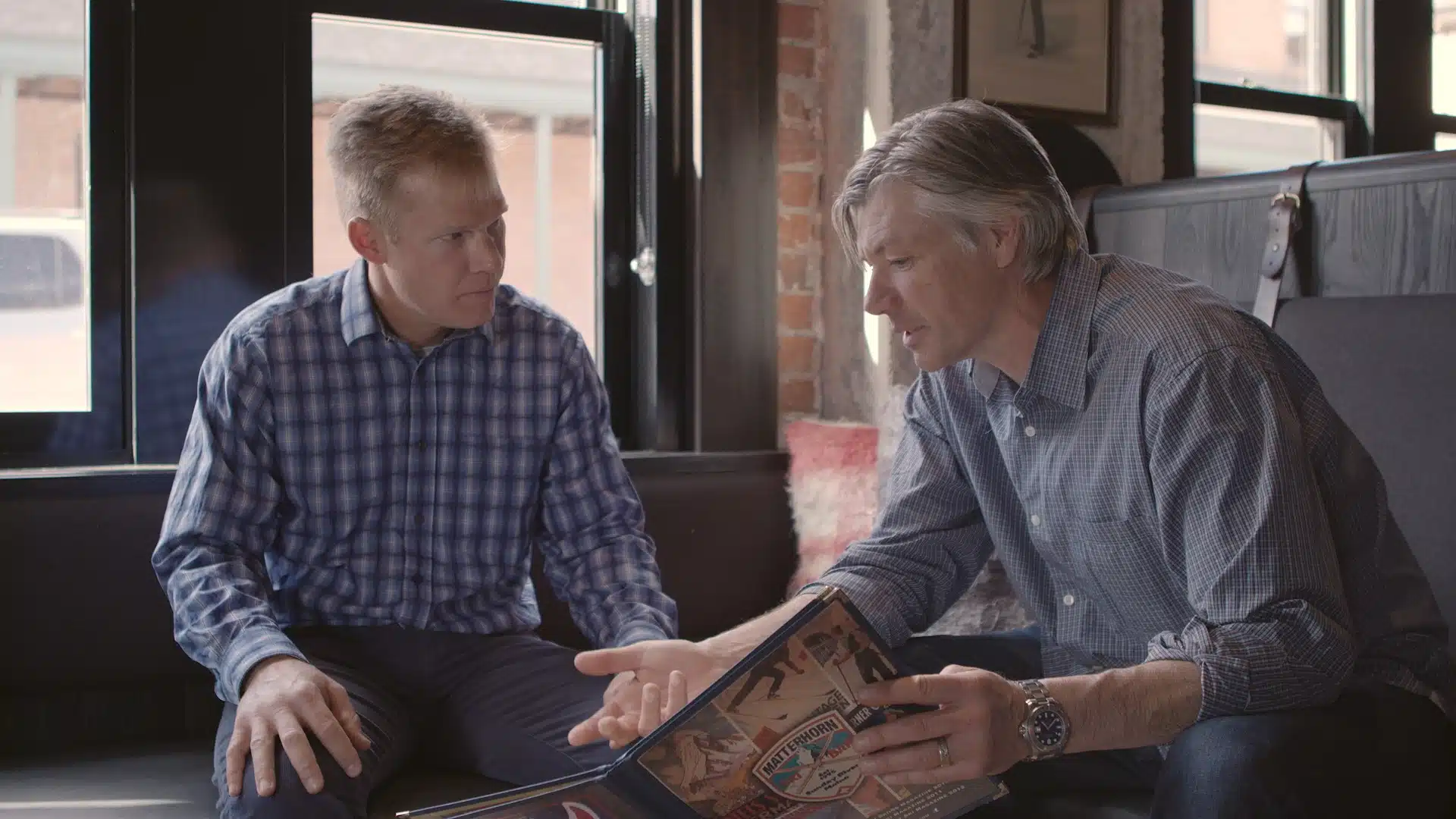
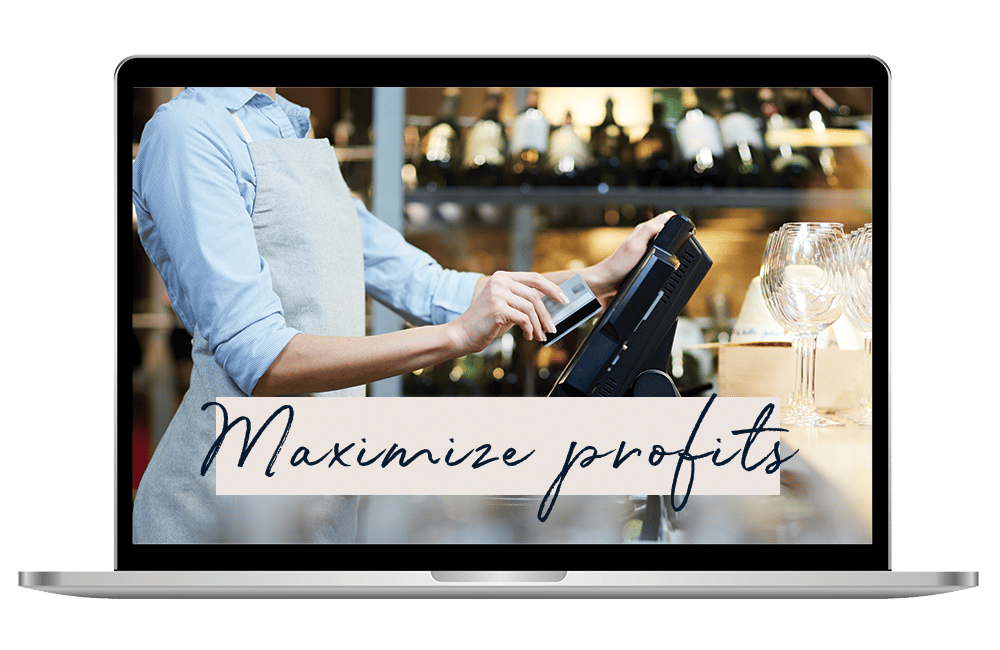
The three costly mistakes you could unknowingly be making?
Find out in this FREE guide and restaurant assessment specifically designed to reveal the unexpected hurdles standing between you and exponential business growth.
Thank You To Our Sponsors
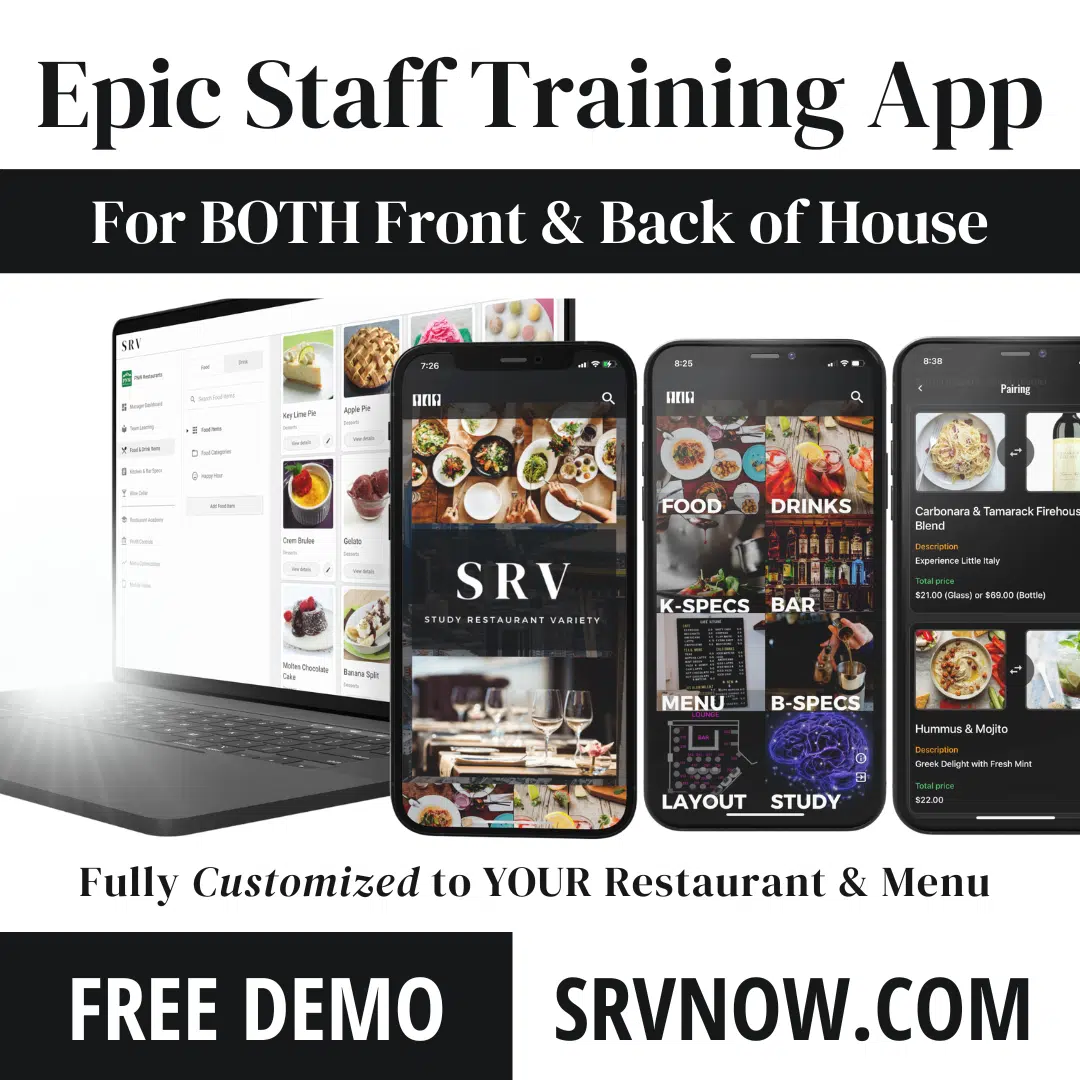

The Employee Retention Tax Credit We will help you determine your eligibility for 2020 & 2021 - Get Started
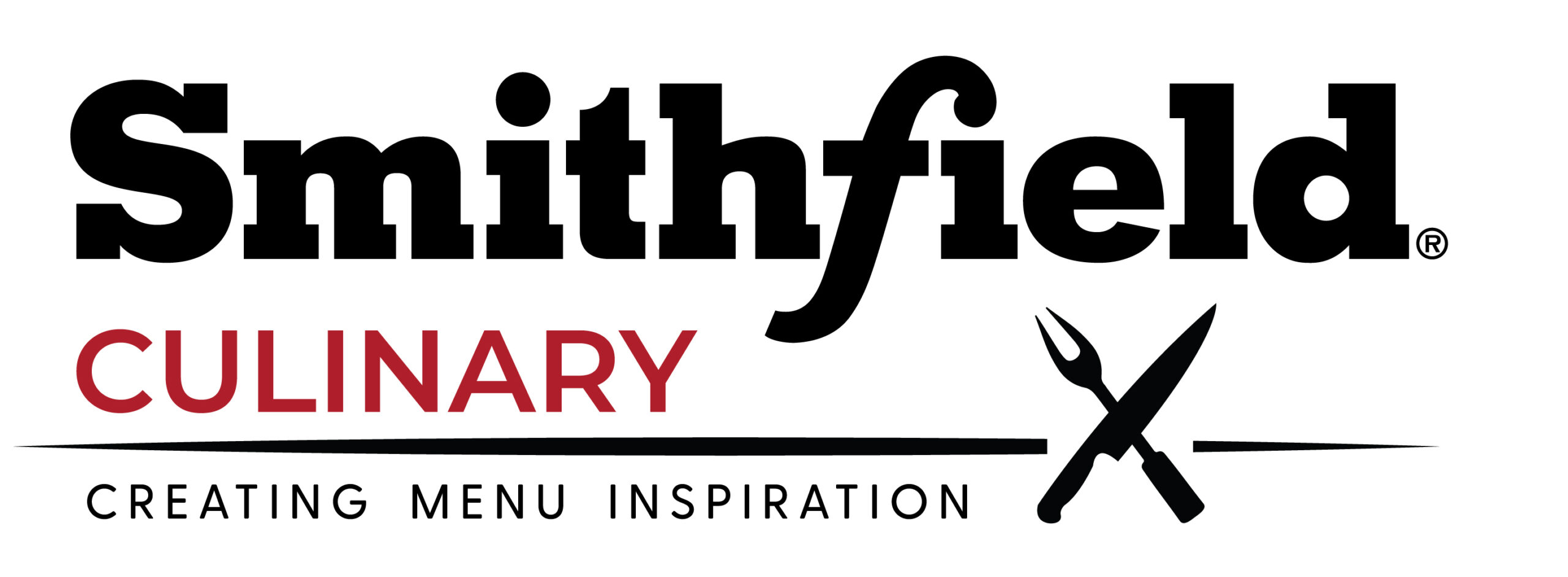
Inspiring Head-Turning Menu Creativity
Culinary Trends & Chef Inspired Recipes - Learn More
Want to become a podcast sponsor?
Please get in touch with Roger at roger@restaurantrockstars.com
